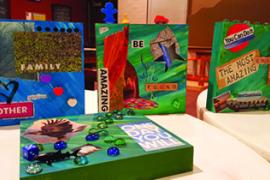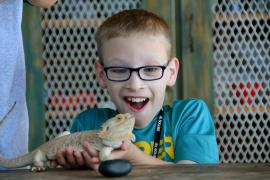So you did it! All your planning and intentionality in working to make connections to nature a cornerstone of your program are paying off. You watch happily as, in those glorious days of camp, children play enthusiastically and freely in the woods near their cabins, finding lucky stones, or making mini-dams in the brook. Or maybe they cleared a vacant lot and planted cucumbers and tomatoes. Perhaps they managed the recycling on their own or worked to conserve water. They learned all the local trees and enthusiastically studied bugs on their way to rest hour. You can see that they are more connected with nature and have a better understanding of their place on our planet and their responsibility for its future. And, just when the changes are real and exciting, off they will go, back to the "real world" of school, sports, computers, and couch-time. Do we just wave good-bye and hope for the best? Do we just plan to continue our work next summer, or are there opportunities here to keep those important connections alive? I am sure that there are many ways to continue your good work through the winter with camp families, and as a real side-benefit, to build those connections to your camp as well. A win-win, in my view, so let’s get started!
Sometimes there comes a moment when doing good in the world coincides with self-interest. If we look for these moments, I contend that they are all around us, just waiting to be discovered. And doing good isn’t any less good if it serves our own purposes. Indeed, in this instance, if you look at all the layers of the question, I believe you will find that everyone benefits at all levels if you work to become a true partner with parents year-round as they work to grow healthy, happy, and responsible children.
So the bus is here, and the cars pull up on the last day. There are tears, naturally, and grateful parents filled with awe at the growth they see in their kids. How can you capture that enthusiasm and send families home with tools they can use to keep that magic going? In the realm of nature connections, perhaps a handout or an e-mail to all of your families might be a great start. Remind them of all the benefits of a connection to nature — exercise, creative opportunities away from "screens," group play, and quiet alone time, appreciation, and if you are comfortable, the beginnings of awe and spirituality. Tell them of the work you have done during camp and the enthusiasm campers developed for nature as summer progressed. Invite them to join you in developing these connections all through the year. A list on your Web site of fun outdoor activities for families to do close to home might be helpful here. Choose ones that match as much as possible the neighborhoods of our camp families; for example, city activities might well be quite different from appropriate fun for farm children.
If most of your campers live in your neighborhood, your job is a bit easier, as you can point them to great local resources, like parks or open spaces or organizations, for example, scouts or community programs. Even better, have you considered holding events during the fall, winter, and spring at your own camp? A family nature picnic and leaf-peep, a winter tracking party, or a signs-of-spring search might be great fun for all and a snap to organize. Of course, check with your insurer to make sure you are covered and then have a blast! Your camp is a playground your campers already know and love, and they can serve as guides for their families as they explore and play. Serve a little food or invite folks to bring a picnic, and you have made a family memory, just like that!
If your campers come from further afield, a bit more effort and perhaps research might be required. Again, an e-mail or letter telling of the importance of nature connections and your work during the summer is a good place to start. Perhaps you can give more generic suggestions about places to look locally for help. Are there state Web sites of park locations and highlights? Can you ask a parent you know well to give you some ideas in various areas? If you travel to do reunions, can you host them outdoors and involve a favorite camp activity closer to home? Can you invite families to share their experiences on your Web site to give other families some fresh ideas?
Remember there are some great resources on the Web to give you — and your camp families — all sorts of possibilities. Our ACA Web site is loaded with ideas. Check it out! ACA’s Green Spoken Here site for parents at CampParents.org is terrific, offering suggested activities for families in all sorts of neighborhoods. The Children and Nature Web site has a new series on Nature Clubs for Families, which will help as well. Check out www.childrenandnature.org. Also look for The Green Hour at www.greenhour.org. You can tell parents about Richard Louv’s ground-breaking book, The Last Child in the Woods. Richard’s writing has struck a chord across the country, as folks everywhere are understanding the importance of his message.
If grandparents are part of your data base (and it makes good sense to add them, if they are not!), a suggestion that they play a part in getting kids outside might be very well received. After all, many parents are struggling with full-time work and other commitments and may not have the energy to make outdoor play happen. I think that today’s baby-boomer grandparents, healthy and active, with a bit of time and perhaps an easier financial position, may well be the biggest untapped resource in this effort. And that’s not just because I am a "Grammie" myself!
So with a modest commitment in communication, you have accomplished a whole series of terrific goals, both personal and societal. You have demonstrated your commitment to the well-being of children beyond the summer camp window. You have created a partnership on a critical issue with parents and helped them build a healthier family bond. You have probably increased your return rate and spread the word about your camp beyond your loyal families to their friends and neighbors. And, you have demonstrated by your example and commitment just how important camp beginnings can be to our whole culture, as you help families develop habits of active outdoor play. Now, of course, every family won’t take up hiking the Whites or feed birds or clear the vacant lot next door of trash. But, if more families begin to understand Richard Louv’s vital message — one we at ACA understand deeply in our DNA — we will add to the energy supporting children connecting with nature and the world may, little by little, become a healthier, happier place!
|
What Can I do?
|
Posie Taylor serves as chair of ACA’s Task Force on Connecting Children and Nature. A past president of American Camp Association (ACA) New England, she is a National Board member and a passionate ACA advocate since 1977. After her "retirement" from full-time work as executive director of the Aloha Foundation in Vermont, Posie has been consulting on funds development and camp leadership both here and abroad.
Originally published in the 2009 July/August issue of Camping Magazine.


